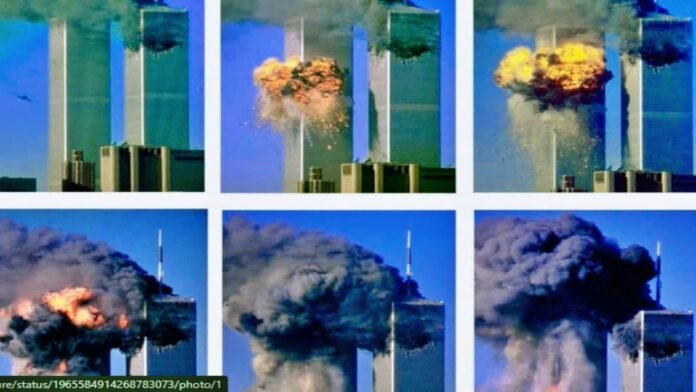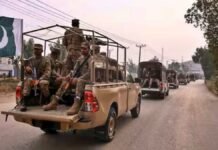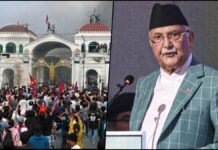
Key Points:
- Today marks the 24th anniversary of the September 11, 2001 terrorist attacks on the United States.
- 19 Al-Qaeda terrorists hijacked four commercial airliners, striking the World Trade Center in New York and the Pentagon in Washington D.C.
- The attacks killed 2,977 people, including passengers, first responders, and workers in the buildings, and injured over 6,000.
- The events triggered the U.S. “War on Terror,” leading to a 20-year military presence in Afghanistan and sweeping changes in global security and air travel.
- Mastermind Osama bin Laden was killed in 2011, but the legacy of 9/11 continues to shape global politics.
New Delhi: Twenty-four years ago today, on the morning of September 11, 2001, America was subjected to the deadliest terrorist attack in its history. The coordinated hijacking of four passenger planes by 19 Al-Qaeda operatives left an indelible scar on the nation’s psyche and set in motion a new era of global conflict and security. The fiery collapse of the World Trade Center’s Twin Towers in New York City became a haunting symbol of a world irrevocably changed.
That day, the United States, a global superpower, was brought to its knees as flames engulfed its financial hub and smoke billowed from its military headquarters. In a historic address to a stunned nation and world, then-President George W. Bush declared a “War on Terror,” vowing to hunt down the perpetrators and eradicate terrorism from its roots.
The Anatomy of the Attack: A Detailed Timeline
The horror unfolded with terrifying precision on a clear Tuesday morning:
- 8:46 AM: American Airlines Flight 11, a Boeing 767 en route from Boston to Los Angeles, crashed into the North Tower of the World Trade Center, striking between the 93rd and 99th floors. Initially, many believed it was a tragic accident.
- 9:03 AM: Seventeen minutes later, the truth became undeniable. United Airlines Flight 175, another Boeing 767 also from Boston to Los Angeles, slammed into the South Tower of the WTC, hitting between the 77th and 85th floors. The impact was broadcast live on television screens around the globe.
- 9:37 AM: The attack expanded to the nation’s capital. American Airlines Flight 77, a Boeing 757 from Dulles to Los Angeles, crashed into the western facade of the Pentagon in Arlington, Virginia.
- 10:03 AM: United Airlines Flight 93, a Boeing 757 flying from Newark to San Francisco, crashed into a field in Shanksville, Pennsylvania. Evidence later revealed that passengers and crew, having learned of the other attacks via phone calls, bravely fought back against the hijackers, preventing the plane from reaching its intended target, believed to be the White House or the U.S. Capitol in Washington D.C.
The Unthinkable Human and Economic Cost
The Twin Towers, which had 16,000 to 18,000 people inside at the time of the attacks, could not withstand the intense fires. The South Tower collapsed at 9:59 AM, followed by the North Tower at 10:28 AM, burying thousands in a mountain of steel and rubble.
14. The bone-chilling footage of the moment when the plane hit World Trade Center on September 11 (9/11)pic.twitter.com/ssbEHGtQ0z
— Wolf of X (@tradingMaxiSL) September 12, 2024
The final death toll stood at 2,977 victims, a number that included the 246 passengers and crew on the four planes, 2,606 people in the World Trade Center and on the ground, and 125 at the Pentagon. Among the dead were 343 firefighters and 71 law enforcement officers who rushed into the towers to save others. In addition, over 6,000 people were injured.
The economic fallout was immense. America suffered more than $100 billion in damages, and the New York Stock Exchange remained closed for nearly a week, its longest shutdown since 1933.
America’s Response and the War on Terror
The 9/11 attacks fundamentally reshaped U.S. domestic and foreign policy.
- Securing the Homeland: The Transportation Security Administration (TSA) was created in November 2001, revolutionizing airport security with stricter screening protocols that remain in place today.
- The Hunt for Al-Qaeda: In October 2001, the U.S. launched an attack on Afghanistan, targeting Al-Qaeda and the Taliban regime that harbored them. The Taliban government quickly collapsed in November 2001.
- Capturing the Masterminds: Khalid Sheikh Mohammed, the principal architect of the 9/11 attacks, was captured in Pakistan in 2003 and has been held at the Guantanamo Bay detention camp ever since.
- Justice for bin Laden: On May 2, 2011, after a decade-long manhunt, Al-Qaeda leader Osama bin Laden was killed in a raid by U.S. Navy SEALs on his compound in Abbottabad, Pakistan.
The 20-Year Legacy in Afghanistan
The U.S. military remained in Afghanistan for nearly 20 years, making it America’s longest war. The mission officially ended in August 2021 with the withdrawal of U.S. forces. The pullout was followed by the swift collapse of the U.S.-backed Afghan government and the return of the Taliban to power, a complex and controversial conclusion to a conflict that began with the ashes of 9/11.
Twenty-four years on, the memory of September 11 continues to be honored with memorials, moments of silence, and a commitment to “Never Forget.” The attacks remain a pivotal moment in modern history, a stark reminder of the devastating impact of terrorism and the enduring quest for security and peace in a changed world.






































